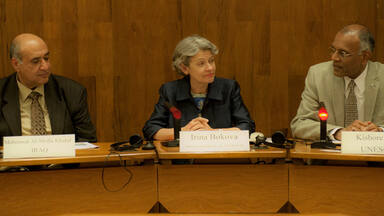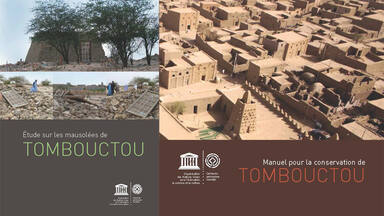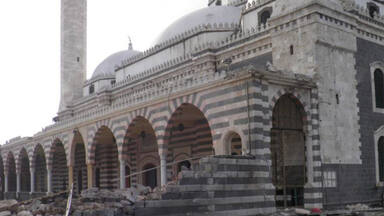UNESCO strengthens action to safeguard cultural heritage under attack
Recent events in Syria, Iraq, Libya and Mali have highlighted the multiple threats to cultural heritage during crisis, including deliberate attacks, destruction as collateral damage in fighting, the greed of unscrupulous traders and collectors, vandalism of factions that seek to erase the achievements of past cultures.
These events have shown the complexity of any intervention to safeguard cultural heritage.
UNESCO has developed a comprehensive set of international instruments to protect cultural heritage. The Convention on the Means of Prohibiting and Preventing the Illicit Import, Export and Transfer of Ownership of Cultural Property (1970) and the World Heritage Convention (1972) provide a solid basis to protect cultural heritage. The Hague Convention for the Protection of Cultural Properties in the Event of Armed Conflict (1954) and its Protocols set further international standards to deal with the specific risks faced by heritage during conflict. In addition, the Statutes of the International Criminal Court have defined the intentional destruction of historical buildings as a war crime. This provides firm ground to address impunity related to such attacks.
Recognizing the powerful role of culture in building social cohesion and contributing to reconciliation and peace, the UN Security Council—in itsResolution 2100 on Mali, and Resolution 2139 on Syria--called for the protection of cultural heritage and diversity. The integration of culture in humanitarian, recovery and reconstruction operations provides the challenging opportunity of defining how cultural heritage protection can effectively contribute to the broader UN crisis response.
UNESCO advocacy and action seek to reaffirm these international standards, secure their implementation at the country level and highlight the broader implications of their violation on stability, recovery and development. In this spirit, UNESCO considers that both the protection of human lives and culture are indispensable and interconnected in the event of conflict. Whenever and wherever cultural heritage is threatened— most recently in Syria, Iraq, and Mali--the Director-General of UNESCO alerts parties and stakeholders about the urgent need to spare cultural and archaeological sites, museums, libraries and archives from the devastation of warfare.
Prioritizing prevention
A key lesson learnt from the implementation of these international standards at the country level, is that prevention and long-term engagement are essential to mitigate the impact of any crisis, be it natural or man-made. This requires strong leadership, as well as national and local capacities that UNESCO helps its Member States build through advocacy and awareness raising, as well as advice and training.
Experience has shown that the preparedness of local professionals and communities is the best guarantee to keep cultural heritage safe when a situation of crisis occurs. For this reason efforts to strengthen national capacities and local awareness on emergency protection of cultural heritage must focus on prevention rather than last-minute endeavours. This is especially true in times of conflict, when it is difficult if not impossible for international assistance to reach affected areas.
Mobilizing for the safeguarding of heritage in times of conflict
More than three years of conflict have taken a heavy toll on heritage in Syria. Despite the courage and commitment of culture professionals to protect their heritage, the scale of destruction and damage is enormous. When and where prevention and mitigation fail, continuous monitoring and early assessment of damage is a priority to prepare a sound and coordinated response for recovery and future rehabilitation. This is why UNESCO has launched a web-based international observatory to monitor the situation of cultural heritage in Syria and help international cooperation to protect the country’s heritage.
Globally, illicit trafficking appears to be one of the worst threats to cultural property during conflicts. When law and public order are challenged, the looting of archaeological sites and museums is not only easy, but highly profitable to criminal groups. UNESCO is mobilized to stop illegal trafficking in cultural properties from countries at risk of pillage, such as Syria and Iraq, in close partnership with the international community, particularly neighbouring countries, and institutional stakeholders; notably INTERPOL, the World Customs Organization (WCO), the International Centre for the Study of the Preservation and Restoration of Cultural Property (ICCROM) and the International Council for Museums (ICOM). UNESCO regularly alerts the art market about its professional and ethical duty to check the provenance of traded artefacts and facilitate the restitution of stolen or illegally excavated cultural properties.
Another major threat to both archaeological sites and monuments, is their military use and targeting prohibited by International law, notably by theConvention for the Protection of Cultural Property in the Event of Armed Conflict (1954). This is when the Director-General of UNESCO raises her voice in statements calling for the protection of cultural heritage, anywhere it is necessary, most recently in Syria and Iraq .
In their Joint Appeal for the safeguarding of Syria’s cultural heritage, UN Secretary-General Ban Ki-moon, UNESCO Director-General Irina Bokova and then UN and League of Arab States Joint Special Representative for Syria Lakhdar Brahimi stressed this important risk and its devastating implications: “Destroying the inheritance of the past robs future generations of a powerful legacy, deepens hatred and despair and undermines all attempts to foster reconciliation. Now is the time to stop the destruction, build peace and protect our common heritage.”
These actions reflect the conviction, repeatedly expressed by the Director-General of UNESCO, that heritage preservation during conflict must go hand in hand with humanitarian assistance and efforts to restore stability. They also pave the way for longer-term response, once pressing humanitarian needs are addressed. A key factor of success is coordination among all actors from the outset. UNESCO’s work is guided by stakeholders whose views and expertise it regularly consults. And these stakeholders have essential roles to play in the response. This is why, in the face of the renewed upsurge in violence in Iraq, UNESCO organized an Emergency Experts’ meeting for the safeguarding of the country’s cultural heritage, bringing together Iraqi and international expertise to design an Emergency Response Action Plan for the protection of the country’s cultural heritage at risk.
 Citadel mound and the southern perimeter - Erbil Citadel (Iraq) © ARS Progetti/UNESCO and HCECR
Citadel mound and the southern perimeter - Erbil Citadel (Iraq) © ARS Progetti/UNESCO and HCECRRehabilitating heritage to build hope, confidence and resilience
Once recovery and reconstruction become possible, UNESCO’s action on the ground aims at supporting national efforts to revive culture, address damages and provide advice to help recovery and rehabilitation. In Libya, UNESCO has facilitated the development of a comprehensive strategy to build national capacities to prevent the looting of cultural properties. A series of specialized training sessions have been held in different parts of the country focusing on the role of police and customs officers. In Mali, UNESCO assists in the rehabilitation of the mausoleums of Timbuktu. The first two destroyed in 2012 have now been rebuilt through a partnership with local communities, but an additional $8 million are needed to restore the entire site, including libraries where hundreds of thousands of old manuscripts had been stored.Anyone who has seen the pride and joy of the local community as rehabilitation advances can understand that there is much more at stake than old stones. It is also about strengthening the resilience and confidence of an entire society, restoring an environment that fosters reconciliation and hope in the future. Culture is a bond that motivates people to work together for a better future. Cultural heritage is also essential for citizens’ to regain a sense of shared purpose and common identity, when the conflicts are over.
The example of Mali must serve to gain full recognition of the great potential of cultural heritage to foster dialogue and strengthen resilience. To succeed, we must mobilize all stakeholders, national authorities, development partners, the culture professions, as well as customs, police and the art market to cooperate and make cultural heritage protection and management a priority.
In addition to its operational action, UNESCO acts as an international platform for continuous reflection on the protection of cultural heritage at risk. It has organized several debates on this topic recently: new wars of the 21rst century, in February as well as and how to protect cultural heritage at risk, in June.




